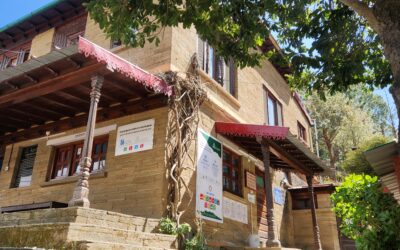Rapar is an “aspirational taluka” i.e. it is a backward and underdeveloped taluka in terms of the government. Hence a subtle and indirect way of saying you are way behind everyone. But the state is behind you and will slowly push you towards development. So it does not mean this area is poor. Everyone here has two square meals a day, a packet of beedis and/or a few mouthfuls of Gutkha. The real poverty lies in the mind.
Work takes me to different villages and hamlets of ever rapidly changing Rapar. I have to meet farmers (men and women) and cattle rearers on a regular basis. The villages today are like teenagers. Since they are struggling to maintain the old village ideology while seeking urbanisation and inching closer to cities.
The Social Need Question
With affordable housing, cleaner air, polluted roads and newly established internet network [thanks to private networks like Jio, Airtel, Vi etc. … BSNL is launching its 4G services soon], there is no longer a need to leave the village for cities. Therefore, staying back has begun to fulfill people’s “social needs”.
What is this “social need” one might wonder. It is the power, status, security and strength that can be drawn from the collective of the village. Isn’t that what the human animal has tried to achieve since eons?
Read More
Where do those who leave go?
Some have figured out multiple income sources and are sorted for their next three generations. Thus, these ‘rich’ farmers hire a “manager” (a farmer who will tend to their agriculture) and leave for an affluent place, city or town. A lot of people of Rapar have a second residence mostly in Mumbai. Hence, one can hear about the dazzling and bewitching city every now and then in the conversations.
Almost every young male has a stint in Mumbai for a short time. Either to try out their luck or move up the social ladder in life through hard work. There is a social benefit of going to Mumbai (Bambai, as people in Rapar pronounce it). A prospective groom can easily find a bride since he has a tag of “staying in Mumbai” or “Mumbai return”.
The ever-changing Rapar
Rapar is an agrarian economy with mining trying to overtake the agricultural lands. The high decibel ‘brrrs’ and ‘grrr’s (engine sounds, heavy movers, highway traffic, mining drills), rhythmic metal clinking and rocks/boulders breaking into smaller pieces are replacing the rather soothing cling and clang of farm equipments, chirping birds and braying and gloating cattle. The clayey soil which has turned infertile due to overuse of fertilisers and pesticides is perfect breeding grounds for heavy movers. Heavy movers here also take the benefit of rich minerals being strewn in this geography around. You will find a mover company in almost every village. The agricultural land is shrinking and becoming infertile right here, right now.
The Far Side
For me, Balasar area is the “Other” side or “Far” side of Rapar. I primarily work from Gagodar, but there is a significant other side of Rapar. I get to peek into it for a week in a month. As one moves upward, the rural lifestyle starts becoming mor apparent. However, the villages on the northern side are significantly polluted by vices and modern industry products (plastics). Water availability and strain in resources starts becoming apparent as well. The communities suffering through acute water storage would be right next to “Vas” or area of communities who have established water security for themselves.
So, how does Rapar sound like? A difficult place to live? An inhospitable place? Empty?
Balasar Bound
What if you were standing in the middle of Balasar, what will you be listening to? Here is a snippet:

One can listen to tempo carriers which are there to pickup workers for farm work in nearby villages. One would also be able to listen to nature (birds and rustling wind), people chattering and animals making their way.
Now let me take you to another place called Mevasa, a village on a highway.
The Mevasa Mix


The trucks never stop running in this corridor. There is always a truck coming in sight and a truck leaving the periphery.
Very different, isn’t it? Rapar is multidimensional and complex. People of Rapar are just like your average Indian community (a bit of patriarchy + a dash of entrepreneurial spirit + afraid of getting out of comfort zone + a new generation finding themselves ghosts of the past and promises of future). The only difference is they are constantly adapting to the harsh geography and political climate.
One day Rapar would seem very familiar and it would almost feel like I have been living here forever and the next day it could feel completely alien. Where one is born and to whom dictates so many dimensions of their lives. What would a Brahmin English educated boy from Godavari Districts (These districts have abundant water and great irrigation systems) in AP make of a Koli boy or a girl who drops out of school in 9th standard in order to tend to their farms in Rapar?
Sounds of Rapar have brought me closer to realities much closer to me at home and also to the truths in Rapar. I urge you to listen to the audios again since these are the sounds of Rapar which will help us resonate with its people.




0 Comments